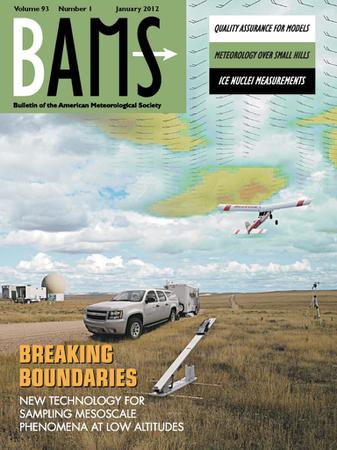QLB-NET:青藏高原青海湖盆地高密度土壤水分和冻融监测网络
IF 5.9
1区 地球科学
Q1 METEOROLOGY & ATMOSPHERIC SCIENCES
引用次数: 0
摘要
摘要 土壤水分(SM)和土壤冻融(FT)是两个相对活跃的地表参数,对水-土地-空气-植物-人类关系的可持续发展具有重要意义。随着时间的推移,已开发出不同空间分辨率的区域或全球土壤水分和土壤冻融数据集。为满足多尺度产品验证和多源不确定性跟踪的要求,2019 年 9 月建立了青海湖流域土壤水分和土壤温度(ST)监测网络(QLB-NET)。青海湖流域土壤水分和土壤温度监测网(QLB-NET)的特点是原位站点分布密集(82个站点),测量5、10和30厘米深度的土壤水分和土壤温度,其中60个站点分布在一个覆盖面积为36千米×40千米的大尺度网络中,22个站点均匀分布在两个1千米×1千米的小尺度网络中。对原位测量的定量分析表明,QLB-NET 可以在较粗的网格尺度(如 36 km×36 km、25 km×25 km 和 0.25°×0.25°)上为 SM 和 FT 提供稳定可靠的地面实况。在对 54 个站点中的 50 个、29 个站点中的 25 个和 28 个站点中的 25 个进行相应统计时,结果描述如下:1)SM 平均值的 STD 在 0.0127 和 0.0196 立方米/立方米之间变化,上四分位数和下四分位数之间的相应差异小于 0.02 立方米/立方米;2)在两个冻融过渡日期,地面冻融状态能够以 85.3%到 100%的高概率被正确识别。通过与国家青藏高原资料中心(http://data.tpdc.ac.cn)的合作,QLB-NET观测数据集已在线发布并将持续更新,这有助于产品验证和不确定性跟踪、SM变化和FT转换的时空分析、SM和FT检索算法和比例方法的优化以及山地微波辐射传输模式的发展。本文章由计算机程序翻译,如有差异,请以英文原文为准。
QLB-NET: A Dense Soil Moisture and Freeze/Thaw Monitoring Network in the Qinghai Lake Basin on the Qinghai-Tibetan Plateau
Abstract Soil moisture (SM) and soil freeze/thaw (FT) are two relatively active surface parameters that are significant to the sustainable development of the water-land-air-plant-human nexus. Over time, regional or global SM and FT datasets with different spatial resolutions have been developed. In response to the requirements of multiscale product validation and multisource uncertainty tracking, a soil moisture and soil temperature (ST) monitoring network in the Qinghai Lake Basin (QLB-NET) was established in September 2019. The QLB-NET is characterized by densely distributed in situ sites (82 sites) measuring SM and ST at 5-, 10- and 30-cm depths, with 60 sites in a large-scale network covering an area of 36 km×40 km and 22 sites evenly distributed across two small-scale 1 km×1 km networks. Quantitative analyses of the in situ measurements show that the QLB-NET can provide stable and reliable ground truth for SM and FT over coarse grid scales, e.g., 36 km×36 km, 25 km×25 km, and 0.25°×0.25°. When statistics are correspondingly performed over 50 out of 54, 25 out of 29, and 25 out of 28 sites, the results are described as follows: 1) the STD of the mean SM varies between 0.0127 and 0.0196 m3/m3, with the corresponding difference between the upper and lower quartiles being less than 0.02 m3/m3; 2) the ground freeze/thaw state can be correctly identified with high probabilities ranging from 85.3% to 100% on two freeze/thaw transitional dates. The QLB-NET observed datasets are distributed online and will be continuously updated through cooperation with the National Tibetan Plateau Data Center (http://data.tpdc.ac.cn), facilitating product validation and uncertainty tracking, spatiotemporal analysis of SM change and FT transition, optimization of the SM and FT retrieving algorithms and scaling methods and development of the mountainous microwave radiative transfer model.
求助全文
通过发布文献求助,成功后即可免费获取论文全文。
去求助
来源期刊
CiteScore
9.80
自引率
6.20%
发文量
231
审稿时长
6-12 weeks
期刊介绍:
The Bulletin of the American Meteorological Society (BAMS) is the flagship magazine of AMS and publishes articles of interest and significance for the weather, water, and climate community as well as news, editorials, and reviews for AMS members.

 求助内容:
求助内容: 应助结果提醒方式:
应助结果提醒方式:


